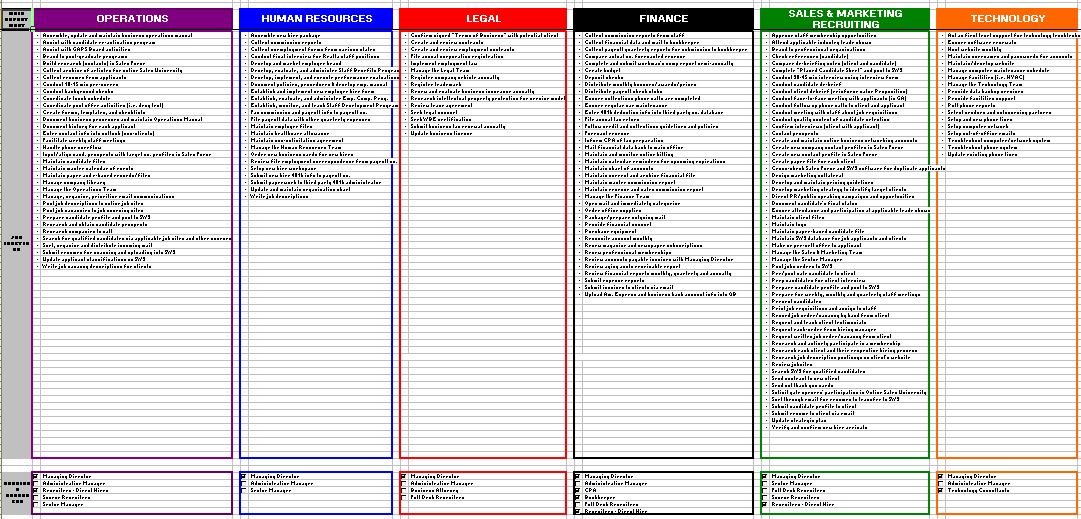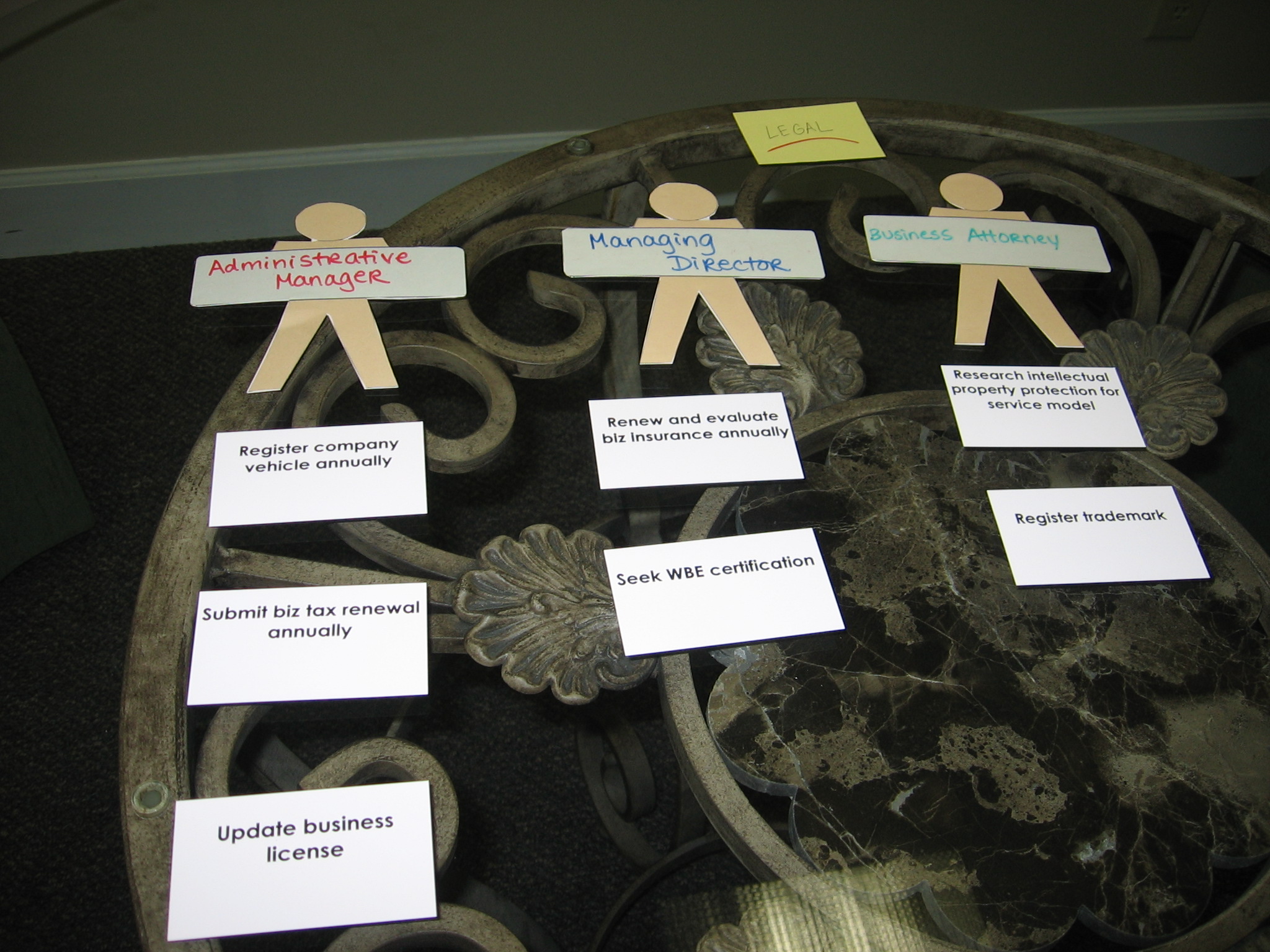Background
BusinessDictionary.com defines a job analysis as the “Detailed examination of the (1) tasks (performance elements) that make up a job (employee role), (2) conditions under which they are performed, and (3) what the job requires in terms of aptitudes (potential for achievement), attitudes (behavior characteristics), knowledge, skills, and the physical condition of the employee. It is the first step in a thorough understanding of the job and forms the basis of job description which leads to job specification.”
At Equilibria, we refer to this as the Business Parts Analysis when working with entrepreneurs and small business owners. It is the first step in creating the business infrastructure that will serve as the foundation for daily operational support.
Value of the Job Task/Business Parts Analysis
By going through the process of defining what needs to be done and who should do it, you can:
- Delineate roles and responsibilities to eliminate task redundancy, reduce waste and save money,
- Stay in control by effectively disseminating office support workload to others without compromising service and/or product quality,
- Increase productivity through synchronization across all departments and activities and effectively cross-train current and/or future employees, and
- Attract and retain top talent through job descriptions that communicate responsibilities, expectations and organizational culture.
What It Looks Like (For Illustrative Purposes Only)
The following illustration highlights the way we typically produce a Business Parts Analysis. It is usually presented as a Microsoft Excel spreadsheet that summarizes each department of the company along with the tasks and personnel assigned to each department. It also includes task segmentation by staff position and indicates whether or not the position is currently filled. This task segmentation information can later be copied and pasted into a job description template for each personnel position.

Setup Steps
-

Copyright 2008. Equilibria, Inc. List all tasks to perform and group like tasks. My preference is to use small index cards where each task is written on a separate card and starts with an action verb. Solicit feedback from your staff as a starting point in developing a robust list of job tasks. Additionally, you can download our Download our Equilibria_BPA Task Identifier 2020 as a guide for brainstorming additional tasks. It is important to record not only the current tasks performed, but those that are not currently being performed (and should be) as well. You can also Contact Us to request assistance in using the BPA Task IdentifierTM.
- Assign a department and color to each grouping of tasks.
- Identify the role/position to perform each task identified per department. You can reference the Dictionary of Occupational Titles for assistance in determining the best name of a particular role. Determine whether each role will be part-time, full-time, intern, outsourced consultant, or independent contractor. In the picture above, this client identified a “Legal” department and assigned identified tasks to the roles of Administrative Manager, Managing Director, and Business Attorney.
- Find a job description template. Document the tasks assigned with each department to a particular position in the Roles and Responsibilities section of the template. Make sure the template you choose includes a brief description of your small business as well as how the nature of the role can change due to business demands and environmental factors. Conduct thorough research on a fair, marketable salary or hourly rate. Yes, this exercise applies to creating job descriptions for outsourced consultants and independent contractors as well.
- Share the newly defined or revised positions with your existing personnel. Start recruiting and interviewing to fill vacant positions. Although this is out of the scope of the services we provide, but there’s a wealth of information on the web starting with SCORE’s eGuide to Small Business Hiring, a free publication that you can download. You should also strongly consider developing a personality, work, and communication style profile for each position. Again, there are several resources available on the web including Kolbe, Myers-Brigg, and DiSC. Use these assessment tools to help you match the right person to each position.
- Prepare to use these newly defined or revised roles and their associated tasks in identifying and creating business processes. Business processes can be thought of as the bundling and sequential order of similar job tasks.
- Revise the job tasks as business needs change. Doing this annually is a good rule of thumb perhaps around the time of performance evaluations.
Case Study
Why This Matters
Most employees thrive in well-structured and stable work environments. It’s no surprise then, that not everyone is suited for working in a small business environment where there may not be immediate opportunity for advancement, minimal (if any) benefits and immediate sensitivity to market fluctuations. The recruiting, interviewing, selecting and hiring process can be an expensive endeavor and entrepreneurs especially have to do all that is possible to minimize liability and get it “right” the first time they hire for a particular position. This is why it is so important that as entrepreneurs prepare for sustainable growth, they position themselves to be able to explain what needs to be done, how work is distributed and the potential opportunities for advancement within their companies. This not only provides clarity for existing and future personnel and clients, but also gives assurance that you run a solid, manageable company with the ability to scale.
Every organization, regardless of size and industry, should be able to articulate its business infrastructure. This includes small businesses! A thorough Job Task/Business Parts Analysis documents all tasks your company performs, categorizes them into departments and identifies the personnel to execute those tasks. Once this is in place, it will provide the organizational framework for developing an organization chart, paper and electronic records management systems and business processes (including service or product delivery). Each of these areas will be explored in detail in upcoming posts. Stay tuned and as always, feel free to ask questions or share your insights in the comments section.











